Istrian Kabola Winery Receives Two More International Awards
September the 30th, 2022 - The well known Istrian Kabola winery is no stranger to international recognition and awards, and two more prestigious international awards will only push this Istrian winery even further into the limelight.
As Morski writes, two international awards - Luxury Awards in the category of Best Organic Wine Production Company 2022 and Prestige Awards in the category of Vineyard of the Year - have arrived at the doors of the Istrian Kabola winery. According to many people, this is by far the most beautiful Istrian estate of all.
Both awards come from the United Kingdom of Great Britain and Northern Ireland, and are annual awards given by respected British publications. The best ones are decided by readers online, as well as by an expert jury.
Connoisseurs of the wine scene know that both of these awards have definitely ended up in the right hands, because the Istrian Kabola winery was the first of all on the Istrian peninsula to venture into organic production, which is why all its labels have had the BIO certificate since back in 2009, and it is also the first winery in all of the Republic of Croatia to have started with the production of wine aged in amphorae.
The awards given to the owners of the winery, the Markezic family, who are still very busy working in the vineyards because this year's harvest is still in progress.
"We started harvesting around August the 25th this year, two or three weeks earlier than in previous years due to the extremely hot and sunny summer. Early Chardonnay and Pinot Gris varieties were harvested, and we're using them to produce our RE Kabola sparkling wine. We've just finished harvesting the Malvasia, which accounts for 70 percent of the total production of our grapes and wine,'' explained famous Istrian winemaker Marino Markezic, announcing yet another excellent wine year.
The vineyards on the estate of the Istrian Kabola winery withstood this year's horrendous drought very well thanks to the soil in the microlocation of Momjanstina, which is rich in marl that retains moisture more easily.
It's worth noting that wine and the production of it has been present within this family and has been a tradition for more than 130 years now, and the Markezic family live in harmony with nature. Their cellars have always been the Istrian avant-garde, their wines are widely appreciated, recommended by the most famous sommeliers and offered by prestigious restaurants in many locations. Their winery in Kanedol is a must-see destination for tourists from all over the world, and the film industry also loves it, given the fact that just a few years ago, scenes for a Hollywood blockbuster were filmed on the property.
"Awards always make us happy, but the best reward is the recommendation of our clients and guests who return to us year after year and truly enjoy our wines," concluded Markezic.
For more, make sure to check out our dedicated Made in Croatia section.
Despite Drought, Istrian Grape Harvest Promises Quality Crop
September the 5th, 2022 - The Istrian grape harvest is promising a high quality crop despite the long period of drought which has threatened Croatian fruit and vegetable production up and down the country so far this summer.
As Morski writes, the Istrian grape harvest has begun, and despite the damage caused by the prolonged drought, the grapes appear to be healthy and the yields, although slightly lower, are of good quality as the recent rains have replenished the berries and mitigated most of the losses.
''I think that the drought has shown its effects and left traces of about 10 percent, we've calculated that there will be less grapes,'' said Moreno Coronica, a winemaker from Umag.
The Markezic family will harvest the usual eight to nine tonnes of grapes per hectare from their vines spanning the rolling hills of Momjan. The first bunches for the production of sparkling wine were harvested about ten days ago, and now Malvasia is being harvested for still wines.
''It's not hard work. It's not really heavy going, it's even a kind of relaxation. There's enough sugar in the berries, the acids are low, which is ideal for Malvasia. Everything is right as far as the grapes are concerned, in terms of both freshness and the sugars. So, we will get a wine with around 13 percent alcohol, freshness around 5.5 and 6 percent acidity,'' explained Marino Markezeic from Momjan.
While the Istrian grape harvest is going on and appears to be quite successful, offering a very welcome breath of fresh air to growers, other plantations of various fruit and vegetables haven't been so lucky in other parts of the country, particularly in Dalmatia and as far as olives are concerned. Inflation is set to push prices up even more, with consumers likely needing to fork out more to purchase these top Croatian products.
For more, make sure to check out our dedicated lifestyle section.
Croatian Wine Moscato di Momiano Gets Protected Designation of Origin Label
August the 10th, 2021 - Croatian wine is well known and respected throughout the world as excellent. The Croatian wine Moscato di Momiano (Muskat Momjanski) is the 18th wine so far to be given the sought after protected designation of origin label.
As Poslovni Dnevnik writes, the Ministry of Agriculture reported that Muskat Momjanski (Moscato di Momiano) has become the 18th Croatian wine to boast a protected designation of origin in the European Union (EU) and that a register of designations of geographical origin of the EU has been entered in eAmbrosio.
On August the 2nd, 2021, the European Commission (EC) announced in the Official Gazette of the EU that the Croatian wine Moscato di Momiano had received the European protected designation of origin, which entered this product in eAmbrosio's register of geographical indications of EU origin, according to a statement from the Ministry.
The procedure for the protection of the name Moscato di Momiano/Muskat Momjanski began after the Republic of Croatia's official and full accession to the EU back in July 2013, when a request was submitted for the protection of the designation of origin for the Croatian wine Moscato di Momiano/Muskat Momjanski.
The request for protection was submitted to the Ministry of Agriculture by the "Vino Momilianum" Association, and the specification for the aforementioned product was prepared by the Institute of Agriculture and Tourism from Porec, as well as by the members of the above-mentioned Association.
The name combines the name of a grape variety (Muscat/Moscato, from the Muscat white variety) and the name of the geographical area (Momjanski/di Momiano) after Momjan, which is located in the northern part of the beautiful Istrian peninsula, famous for its popular wines.
Although the Muscat white wine is traditionally grown to a greater or lesser extent in various parts of Istria, Momjan has long been known as a typical area for growing this particular type of wine.
For more, follow Made in Croatia.
Vinistra 2021: Favourite Wine Event Opens in Poreč!
June 19, 2021 - Vinistra, this year, has been a celebration of Istria´s endeavours in containing COVID. Cancelled last year and postponed this year by a month, until everyone could be sure that it was safe, this year´s exhibition has moved from its usual venue in Porec to an open-air one on the seafront, where the safety of exhibitors and visitors is easier to maintain.
The awards were presented at a ceremony a week ago in Porec´s premier Hotel Parentium and this weekend, visitors have the opportunity to sample the best of Istria´s wines over a three-day period.
Vinistra is the culmination of a period of wine events, particularly the World of Malvasija, where Malvasijas from as far afield as Lanzarote and Greece are judged separately from the other grape types. Naturally, most are from Istria, but entries also came from Italy and Slovenia as well.
The Vinistra judging encompasses all the grape varieties available in Istria, including ones like Refosk that are popular in Slovenia, from which entries came and which got a lot of Gold Medals. Judging this year was a little different, as Caroline Gilbey MW, who normally leads it, was stuck in the UK with restrictions and was unable to come.
It isn't just about the big names, either. Denis Bernobic, who has a small winery in Markovac, was previously little known and doesn't even have a website, carried off the supreme award, over and above a Gold Medal, for his Young Malvasija. To have done so, while competing with the biggest and best wineries in the county, was no mean feat. Over 40 Malvasijas got Gold Medals this year, reflecting the very high standard.
Terans, Istria´s other main grape, was well represented with almost 20 Gold Medals of which Marko Fakin from Brkac picked up 5. His neighbour, Klaudio Tomaz, picked up another 3 of them. The Motovun area is clearly good for growing Teran, but the skills of these winemakers make the most of it. Kozlevic, Benvenutti and Degrassi also got Golds, as well as Deklic, from Ferenci, who picked up 2. Bruno Ferenac, his neighbour, picked up another Gold.
The lack of opportunity last year to have wine judged meant that this year many wineries submitted the wines they would have done last year, as well as those for this year. It has resulted in a greater number of entries.
Talking to winemakers about the effects of COVID on their businesses revealed that while the closure of restaurants, both here and in the export markets, obviously hit sales, many of them picked up new business domestically, as buyers bought to drink at home.
I used to think that Cuvees was just a way of blending in different wines, but the skill of these winemakers ensures that the result exceeds the sum of the parts. Deklic picked up 2 Gold Medals for his ones, with Damjanic, down in Fuskulin, getting his usual Gold for his excellent Clemente. Kozlovic, Degrassi and Rossi got Golds, as did Moreno Ivancic and Pervino from Novigrad. Damjanic also picked up the only Gold for his Borgonija. Whilst a traditional grape, it needs careful management and bunches removing to maintain the best of the remaining ones.
Cabernet Francs were less well represented, with another Ferenci winemaker, Julio Ferenac, picking up a Gold for his, alongside Degrassi´s well-known Contarini from Savudrija. Fiore, from Barboj, were the only other entry and got a Silver.
Deklic has done well this year, as he picked up a Gold for his Cabernet Sauvignon, as did Pino Rossi from Bajkini. Rossi´ś cousins, also at Bajkini, picked up a Gold for their Chardonnay, as did Franko Cattunar at Nova Vas.
Siljan, from Marcana, another lesser know winery, got a Gold Medal Plus, for their Merlot, and Deklic, again, got another Gold for his, alongside Tomaz and Medea with Angelo Brcic getting a well-deserved one for his Merlot Barrique.
Benvenutti got a special Gold for his San Salvatore Muscat. That guy makes the best proper dessert wines in the county. Klaudio Tomaz picked up 2 more Golds for his 2018 and 2020 Muscats . Capo, from Fernetici, got a Special Gold for his Yellow Muscat.
The exhibition is well laid out, allowing for a degree of social distancing and being held later in the day, offers a particularly pleasant view across the bay.. This year, following an earlier tradition but missing in recent years, the price of admission includes a glass, which you can keep. It is also part of their thinking to keep patrons safe. Hastily rinsed out hired glasses weren't considered ideal.
This year, there aren't any food events and there isn't a lecture programme, but, overall, they have made a good job of organising it in difficult circumstances.
For more on lifestyle in Croatia, follow TCN's dedicated page.
First Istria Wine and Walk Successfully Held Since Start of Pandemic
June 8, 2021 - After a year in which several events had to be canceled or postponed due to the pandemic, the first Istria Wine and Walk made a successful comeback marked by sold-out tickets and 450 participants who enjoyed the best of what Istrian wine and grapes can offer.
Tasting top wines and food, a relaxed atmosphere, and hours of enjoying the beauties of northwestern Istria marked the spring Wine & Walk, reports Turističke Priče. It has been shown that everyone is eager for such events after various restrictions and bans due to the coronavirus pandemic. This is supported by the fact that the tickets were sold out in less than 24 hours.
This is not surprising as this was the first Istria Wine and Walk since the pandemic was declared. The event was ideal, as it was possible to ensure compliance with all epidemiological measures.
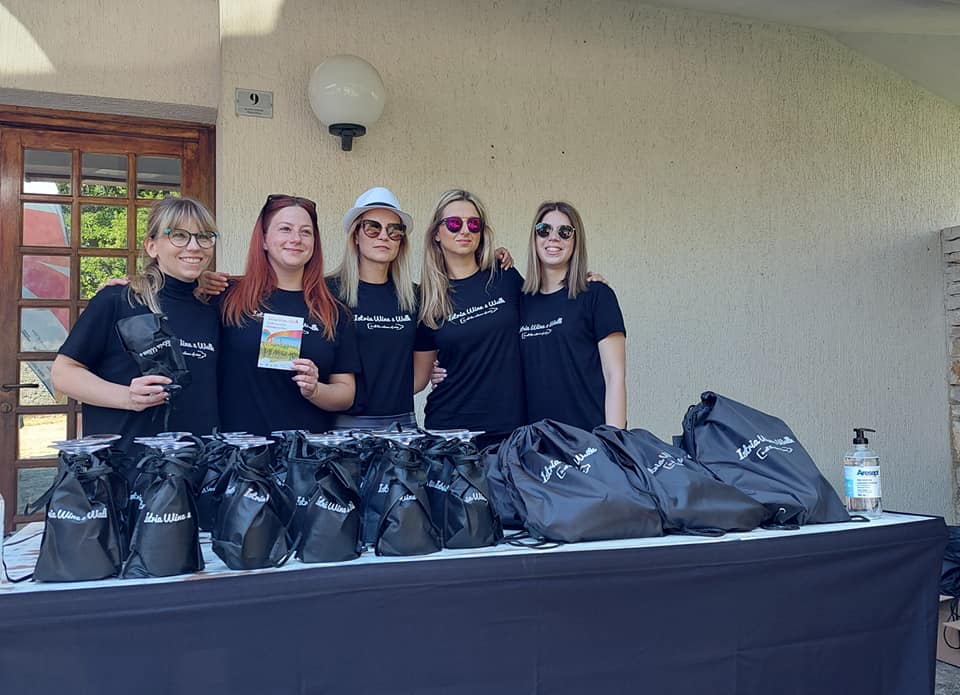
Photo: Istria Wine and Walk
The inspiring walk was attended by 450 participants who were divided into groups accompanied by a guide. The starter kit of the event, which included a tasting glass and a folder, this year's first Istria Wine and Walk event was "conveniently" enriched with a protective mask.
The walk started from the Aleksandar Rukavina Gallery in Brtonigla, and every kilometer and a half the participants were greeted by a new wine & food station with an offer of local Istrian producers and caterers. The offer included wines Benčić, Novacco, Coronica, Cattunar, Cuj, Veralda. The gourmet offer includes Circolo Bar, OPG Radošević, All event, Primizia Food & Wine, Konoba Morgan, OPG Buršić, Veralda. The length of the walk was nine kilometers, and the winemakers, in addition to offering their wines, introduced the participants to viticultural practices and oenological techniques in the production of their wines.
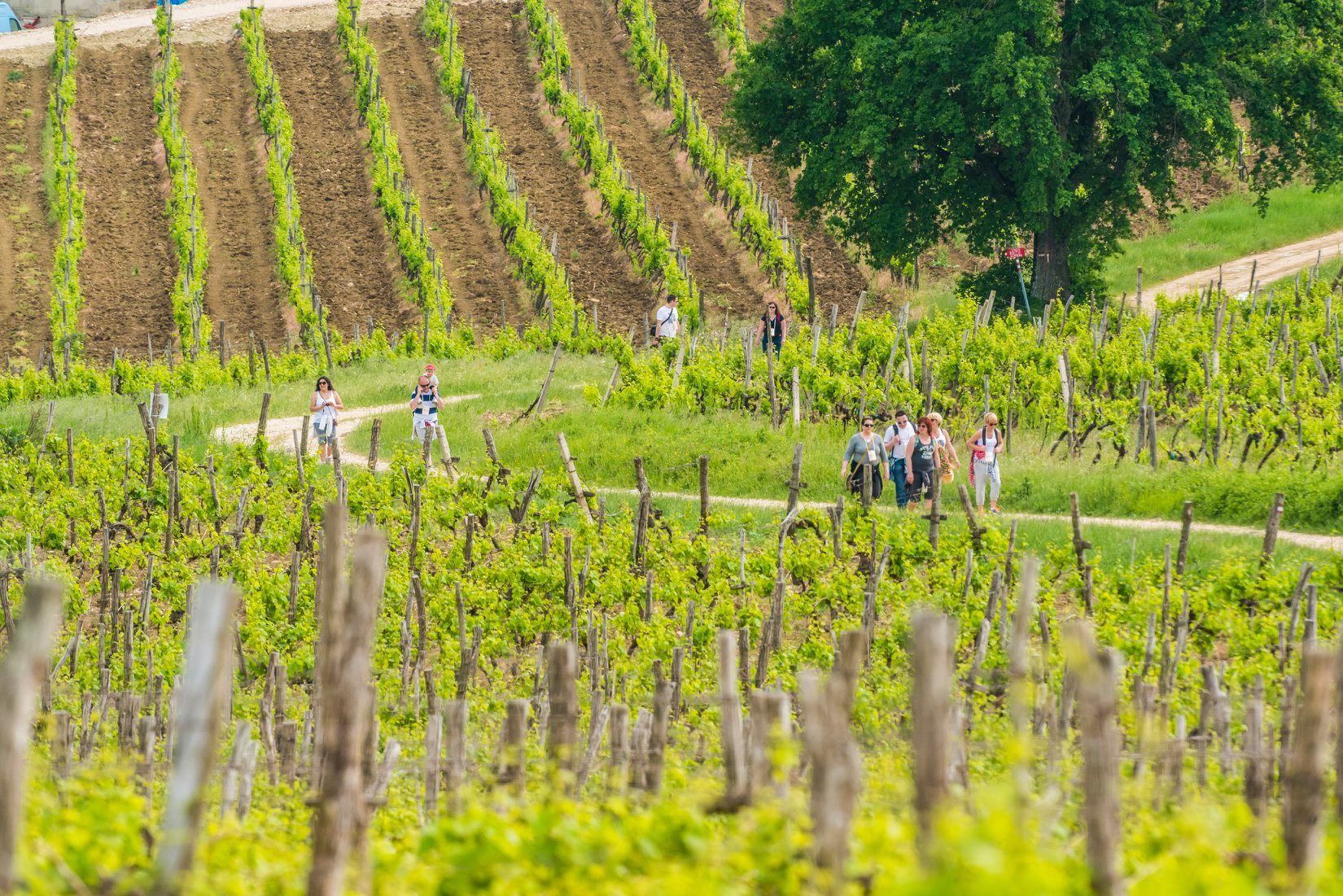
Photo: Istria Wine and Walk
Hikers and wine lovers enjoyed a panoramic view of Brtonigla and the sea from Monte Marzari, visited the cheese factory and farm Radošević from where they had a panoramic view of another Istrian pearl - Buje, the walk stretched to the Nature Park Škarline, wine cellar Cattunar, Tavern Morgan, and the Veralda wine cellar. Once again, intoxicated by the sun and a beautiful day, the walkers returned to the center of Brtonigla where they enjoyed the magic of this Istrian town.
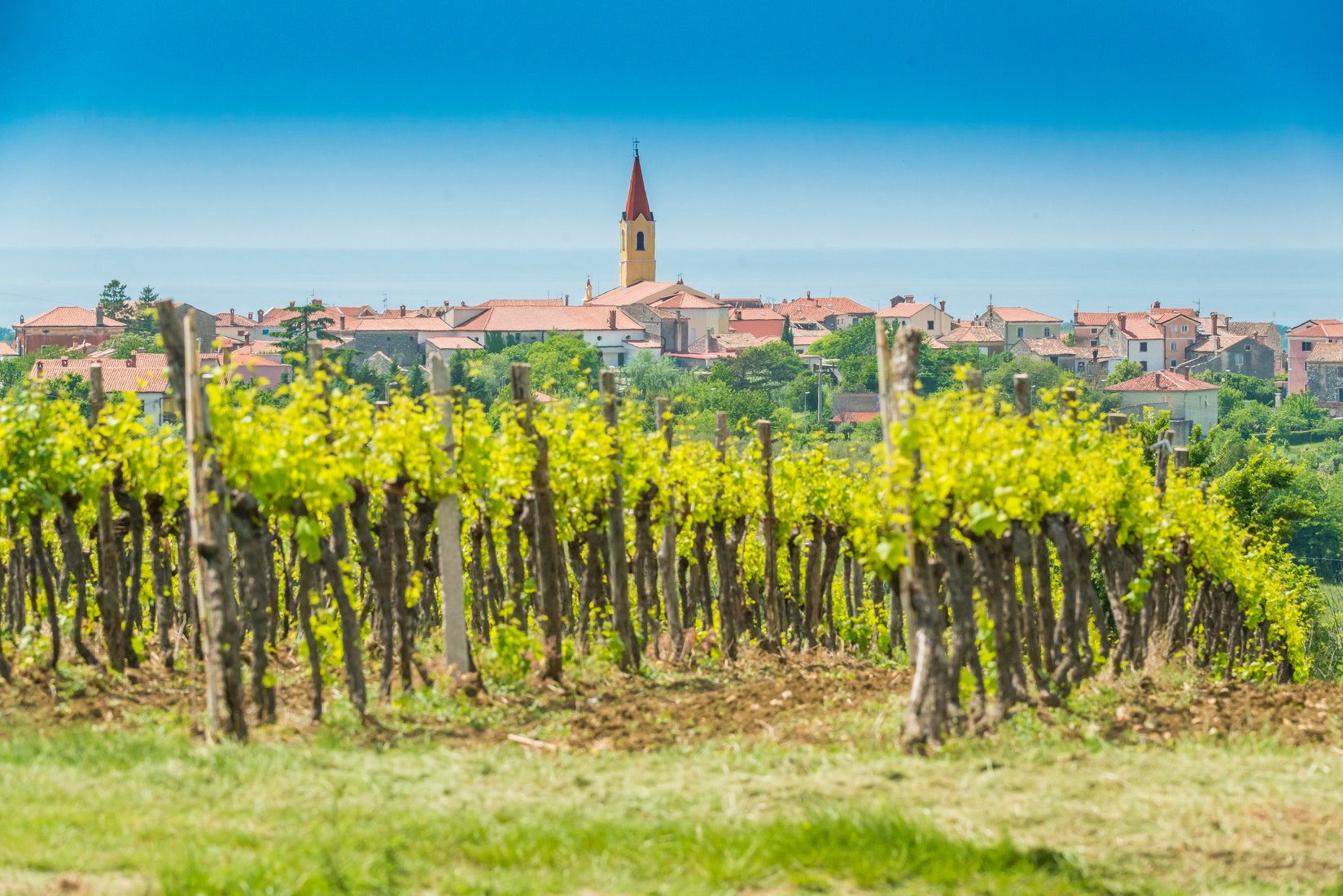
Photo: Istria Wine and Walk
Istrian wines and grapes are among the best in the world, and you can find more information about them in Total Croatia’s Guide to Croatian Wine HERE. You can also learn more about what the Istrian peninsula cities and towns like Pula, Rovinj, Umag, Motovun, and more can offer you on your next trip, in Total Croatia HERE. Total Croatia’s articles are now available in your language!
For more on travel in Croatia, follow TCN's dedicated page.
Istrian Kabola Winery Sees Inheritance Turn into 130 Years of Tradition
May the 28th, 2021 - Croatia is very well known on the wine map for the fantastic products it sends out into the world, and the Istrian Kabola winery has seen inheritance turn into 130 years of tradition.
As Poslovni Dnevnik/Marta Duic writes,reliability, tradition and consumer confidence are the key to the success of any wine heritage story, and those points are all more than well known and applied by the popular Istrian Kabola winery, which is set to celebrate its 130th anniversary at the end of this month.
As many as three generations of the Markezic family have been making wine there, and they have been writing their own very long wine story since way back in 1891, when ''nono Ivan'' filled up the very first bottles of Muscat of Momjan, a variety that still intrigues those familiar with the wine world today.
Respecting tradition and nature, the current owner of the Istrian Kabola winery, Marino Markezic, with his innovative approach to winemaking, has positioned the family winery at the very top of the Croatian wine scene, which is no easy task. He was the one to open the Istrian Kabola winery officially in Kanedol near Momjan back on May the 29th, 2005, and this date is symbolically celebrated as a birthday.
The very first Istrian winery in terms of eco production
The Istrian Kabola winery is the very first Istrian winery that maintains its vineyards according to the stringent principles of eco production. With twenty hectares of vineyards to think about and take proper care of, Kabola produces about 100,000 bottles of wine a year, as well as another much loved Croatian product - olive oil, which also carries a bio-certificate. Although Croatia is their most important market, their exports to various countries have been growing more and more over recent years.
They mainly export to EU and non-EU European countries - Austria, Slovenia, Germany, Italy, France, Belgium, the Netherlands, Great Britain, Serbia, Bosnia and Herzegovina and Montenegro, and some of their wine travels over the Atlantic and finds its place on dinner tables in the United States. These are typically the Kabola-made wines that are chosen by more demanding consumers, both in retail and restaurants, hotels, and 25 percent of the quantities produced are exported.
Prolonged macerations such as those aged in amphorae or wooden barrels are especially sought after. The Istrian Kabola winery isn't only a synonym for top quality wines, as guests from all over the world, as well as various celebrities, come to this Istrian estate in person.
It was on this very estate that a 2Cellos video and scenes for The Hitman’s Wife Bodyguard, among other things, were filmed.
"We're really looking forward to the summer tourist season and we hope that it will be better than last year when, due to very well known circumstances, we had a drop in visits when compared to 2019. Although results like those from two years ago aren't expected yet, our regular guests who spend their summers in Istria never miss out on a visit to our estate for wine tasting and they've already announced their arrival. Since the opening of the Istrian Kabola winery this spring, we've been mostly visited by local guests, but with the easing the anti-epidemic measures, we expect guests from our traditional foreign markets,'' said Marino Markezic, Kabola's owner.
''We're constantly investing''
It's worth noting that the Istrian Kabola winery is mostly visited by guests from Slovenia, Italy, Austria, Germany, France, and a large number of guests come from the Asian market.
“Despite the great challenges for winemakers, the last wine year was great and provided wines of excellent quality. However, the challenges of the coronavirus pandemic were too great, we had to adapt quickly to the new situation and immediately switched to online sales and increased our social media presence and marketing to ensure our customers could easily reach our wines in spite of the lockdowns.
We're constantly investing in equipping the winery and cellar in order to achieve the best possible quality of wine and olive oil in our production process,'' concluded Markezic.
For more, follow Made in Croatia. For all you need to know about Croatian wine, bookmark our dedicated section.
Istrian Wine in International Spotlight Thanks to Croatia Unpacked
April 12, 2021 - Saša Muradori and Tanya Schmitt are the founders of Croatia Unpacked, with which they seek to popularize Croatian wine in Canada. Their company has been recently featured this month in an article in The Circular - the monthly publication by The Circle of Wine Writers - the world's leading international association of authors, writers, journalists, bloggers, broadcasters, photographers, and lecturers, communicating about wines and spirits.
Tanya was interviewed by award-winning wine writer & editor of The Circular, Amanda Barnes, about her interest in wine, her experience with Croatia Unpacked in the wine industry in Canada, and her passion for Istria. TCN transmits the full interview with Tanya:
What sparked your interest in wine?
I’ve always enjoyed wine, but it was when I met my husband – a self-confessed old-world wine snob – in 2005, that my interest was really sparked. Thanks to some wonderful trips (the only rule we have when we travel is to eat and drink local) and many enjoyable dinners, my palate swiftly evolved, and I quickly became a wine lover with, who would have guessed it, a preference for old-world wines…
It was, however, only when we discovered Croatian wine that I ever considered entering the wine industry. Croatia produces intriguing wines that, on tasting for the first time, were both familiar to us yet, at the same time, totally unique. Before I knew it, I found myself on a fascinating journey of discovery – exploring wine regions where indigenous grapes thrive, and where the influence of Croatia’s distinctive terroir is ever-present. Although I am no wine expert, I was quickly convinced that this was a wine experience that deserved attention.
You’ve been involved with Croatian wine and tourism since 2019. What attracted you to Croatia initially?
I am English, my husband Dutch, and outside of work, we are history & art lovers, explorers, foodies, and wine lovers. We live in Canada today, but holidays typically take us back to Europe, where we jump on a motorbike and hit the open road. Before heading out on a road trip a few years ago, a friend recommended that we visit Istria (northwest Croatia, a short hop from Trieste in Italy).
We took his advice and discovered a region so culturally rich yet relatively undiscovered, a gourmet paradise and a land of opportunity. During our short stay there, we visited one of the best-maintained roman amphitheaters in the Mediterranean, learned about the ancient technique of Amphora winemaking at a beautiful local winery, saw mosaics in Poreč that rival those in Ravenna, and were wowed by the food and wine scene. As entrepreneurs, we also saw incredible potential: gaps begging to be filled in the tourism sector, as well as opportunities to introduce the relatively unknown yet extremely high-quality local produce to the global stage, to name but a few.
You also co-founded ‘Experience Istria’. What do you think is the quintessential Istrian (tourism) experience?
Istria is a hidden gem. In recent years it has been labeled the “New Tuscany” – and with good reason. I often say to people that if you were parachuted into Istria, you could easily be mistaken for thinking you were in Italy, but a very rustic, natural version of its more developed neighbor. Tourists typically flock to Istria’s Adriatic coastline, with destinations such as “Venetian” Rovinj, being an eternal crowd-pleaser.
For me, however, it is time spent in the hinterland of Green Istria that reveals the true, authentic heart of the region. Picture a landscape of rolling hills, medieval hilltop towns, mysterious truffle-laden forests, and olive groves and vineyards stretching as far as the eye can see.
In October 2016, my husband and I visited Istria in the “off-season” for the first time. It was during this trip that we promised each other we would return at this time, every year. Autumn in Istria is difficult to beat. You will find yourself treated to the pungent aroma of generously shaved white truffles in the traditional konobas (local restaurants) scattered around the interior. Take a truffle hunt with a trusted guide and you may be lucky enough to find one yourself! It is also harvest time for both grapes and olives. As you roam the endless wine and olive oil roads, you will witness the locals coming out in their dozens to gather the precious fruits by hand, which will soon be lovingly transformed into the next great vintage, or in the case of olive oil, into liquid gold.
Unknown to many, Istria has been named the best olive oil-producing region in the world for the last 6 years, and an olive oil tasting experience is not to be missed. Istrians are proud of their cultural heritage and this can be witnessed in Autumn through a host of local festivals filling the cobbled marketplaces of hilltop towns. As an added bonus, with the summer crowds long gone, all that the region has to offer can be explored in relative isolation.
What really excites you about Croatian wine at the moment, and what do you think wine writers really ought to put on their radar?
I am excited about seeing Croatian wine increasingly recognized on the international stage. The tally of awards at the top competitions is growing year after year, and the global exposure to Croatian wine seems to be growing with it. This is a trend that I hope we will see continue.
The pandemic has, without doubt, been extremely challenging for the wine industry, as it has for many others. I do believe however that there has been one key learning out of it that will hopefully benefit Croatian winemakers in the long term. It is not easy to sample Croatian wine outside Croatia. Exports are notoriously low, with the output largely being consumed within the country by locals and tourists, with minimum quantities making their way to some fortunate countries throughout the EU.
With restaurants shut down, and tourism at all-time lows in the last 12 months, many winemakers have recognized the importance of diversifying their sales channels. This heralds an opportunity not only for the winemakers but also for inquisitive wine lovers, with previously unheard of varietals making their way onto wine shelves around the world. A few years ago, the intrepid explorer in search of sampling Grk, would have no option but to make the journey to the distant island Korčula, off the Dalmatian coast. To think that this wine will be available in Ontario (Canada) this summer is pretty exciting!
As for what I would like to see wine writers put on their radar, my answer would be Croatian wine! There is still relatively little coverage of the region, which historically may be tied to the low exports and thus lack of availability. However, as more and more wine agents, ourselves included, are bucking the trend and focusing on making Croatian wines available around the globe, it would be great to see wine writers embracing this evolution, and helping to educate consumers on this emerging new old-world wine destination.
Which Croatian wines are particularly resonating with the Canadian market? And what is the greatest challenge in selling Croatian wine to Canada?
The greatest challenge in selling Croatian wine in Canada is education. Croatia is not recognized by the average Canadian wine consumer as a wine-producing destination, let alone an old-world wine region. This is somewhat understandable, given that 12 to 18 months ago, you would have had to search high and low to find a single bottle of Croatian wine on a physical, or virtual, store shelf across Ontario – Canada’s largest province.
Changing this perception takes time – it will not happen overnight, but we are confident that it will happen. With the goal of shifting this perception, we spend significant time on promoting the brand of Croatia as a whole, rather than the brand of winery A or winery B. The wineries we partner with understand this challenge and have taken steps to form an association with this collective goal in mind. We are cautiously optimistic that, thanks to this association, we will secure EU funding in 2021 / 2022 for some pretty exciting promotional activities that will take place both in Canada and Croatia (as the situation allows). In the meantime, we are starting to see a shift emerging. As more wines are available on the market, inquisitive wine lovers are excited to try new varietals, are intrigued by the taste profiles, and, invariably, are surprised by the quality.
Wines with a great story are definitely resonating with the Canadian market. For example, the majority of Canadian wine lovers may not be familiar with Plavac Mali, but they most definitely know Zinfandel. Plavac Mali is the renowned offspring of 2 ancient Croatian varietals, one of which – Tribidrag – is in fact the original Zinfandel. Telling this story draws an immediate connection in the mind of the consumer with something known and trusted, and it has definitely opened the door to a new and growing following for Dalmatia’s flagship red. Followers now start to embrace Plavac Mali and compare it to a Californian Zinfandel, in the same way, others compare a Burgundy to a Californian Pinot Noir.
We have, most recently, had incredible success with Dalmatian Dog Babić from Testament Winery. Babić is a lesser-known varietal, comparable to the much loved Italian Chianti. It is the price to quality ratio of this wine, outshining similar wines from its Adriatic neighbor, that has contributed to its success, with its latest release in Ontario selling out in less than a week. This will not be a one-off. There are many other success stories like this just waiting to be told!
Finally, do you have any exciting travel plans post-pandemic? What’s next on your bucket list?
Like so many, I am longing to travel again, once it is safe to do so. Priority number one will be spending some time with my close family in England. After this, we will definitely be heading back to Istria, hopefully just in time for white truffle season!
In a few year's time, we are looking forward to calling Istria home. In addition to the pleasure that we know this will bring us in our daily lives, its central location, in the heart of Europe, also opens up easy access to a range of new bucket-list targets. First on our list will definitely be riding on our motorbike into Istanbul!
If you are interested to get a taste of Istria from the comfort of your home, then please join Tanya, and her co-host Wanda Srdoc, on April 24th at 6 pm for "An Evening to Experience Istria" - a gourmet escape to Istria with wine and truffles!
To read the original article by The Circular, click here.
To know more about wine in Croatia, read our Total Croatia dedicated page.
To read more about lifestyle in Croatia, follow TCN's dedicated page.
Istrian Kabola Winery Drags Malvazija Wine from Depths of Adriatic
April the 10th, 2021 - The Istrian Kabola winery is sure to attract guests from near and far with the wines it has made and then aged under the surface of the sparkling Adriatic sea.
As Poslovni Dnevnik/Marta Duic writes, the Istrian Kabola winery has presented its Malvasia (Malvazija) Under the sea from the year 2017. It is a wine that has been aged for a year at a sea depth of 22 metres, in total silence and semi-darkness and kept under pressure at a temperature of seven to twelve degrees Celsius.
As they pointed out from the Istrian Kabola winery itself, unlike the Malvasia of the same year that was aged in the cellar in Canedol near Momjan, this limited edition of 200 bottles has totally kept its freshness.
"This is a good way to check the quality of our Malvasia, to see what the wine tells us after undergoing this sort of treatment, and it's a special feeling when after a year you pull it up out of the depths of the sea and taste it right on the shoreline.
It's a real pleasure for us winemakers, and it's a special experience for our guests when they discover new sorts in Malvasia from their original bottles onto which shells have attached themselves,'' explained Marino Markezic, the owner of the Istrian Kabola winery, who has dropped Malvasia wine down into cages in the Adriatic four times now.
Back in March this year, this winery opened its doors to visitors and reopened for wine tastings despite the coronavirus pandemic threatening every industry imaginable. With twenty hectares of vineyards at their disposal, Kabola annually produces about 100,000 bottles of bio-certified wine, which they deliver to the very doorsteps of their customers if they so wish.
They also produce their own Kabola olive oil, which is of course also bio-certified. Although the Republic of Croatia is naturally their most important market, their exports have been growing over recent years.
They mainly export to the countries of the European Union and Europe in general - Austria, Slovenia, Germany, Italy, France, Belgium, the Netherlands, Great Britain, Serbia, Bosnia and Herzegovina and Montenegro, and some of their wine even heads across the Atlantic all the way to the United States of America.
"Our winery is especially attractive to our European guests. We're mostly visited by guests from Slovenia, Italy, Austria, Germany, France, and on top of that, a large number of guests come from the Asian market. However, since last year, due to the whole situation with the ongoing conronavirus pandemic, which has strongly affected the travel industry, most of our guests are still from right here in Croatia,'' pointed out Markezic.
For more on Croatian wine, click here.
Historical Mystery: Dinosaurs Secret to Top Istrian Wine and Olive Oil?
August 30, 2020 – Dinosaurs may have disappeared 65 million years ago, but before that, they lived, multiplied, and died here in Istria for a full 80 million years. Are they the secret to top Istrian wine and olive oil?
As Jutarnji list/Mladen Gerovac writes, it is not possible that dinosaurs haven't left any other, invisible traces in Istria apart from footprints and bones. Even though this has not been scientifically confirmed, the fact that these huge intriguing creatures have lived on this soil for millions of years raises questions as to how they lived and the traces they left.
There are numerous traces of dinosaurs in Istria: on Veli Brijun, Kamenjak, in the bay near Bale, on the islets of Fenoliga and Levan, on the Marlera peninsula... Therefore, educational trails have been set up, dinosaurs' bodies have been shaped, and exhibition and amusement parks have been designed with them as the main characters.
Dinosaurs have been treading this soil for millions of years, living here, breeding, turning the local forests and glades of that time into their pastures, hunting grounds, nests, and promenades. But why right here on the coast of Istria? How did they live and how did they disappear?
Did they leave some more traces on this land where we walk, sail, host tourists from all over the world, and enjoy beautiful landscapes? And especially the fruits of this specific Istrian land: in the best olive oil, in top wines, fruits, vegetables, prosciutto, cheese, truffles...?
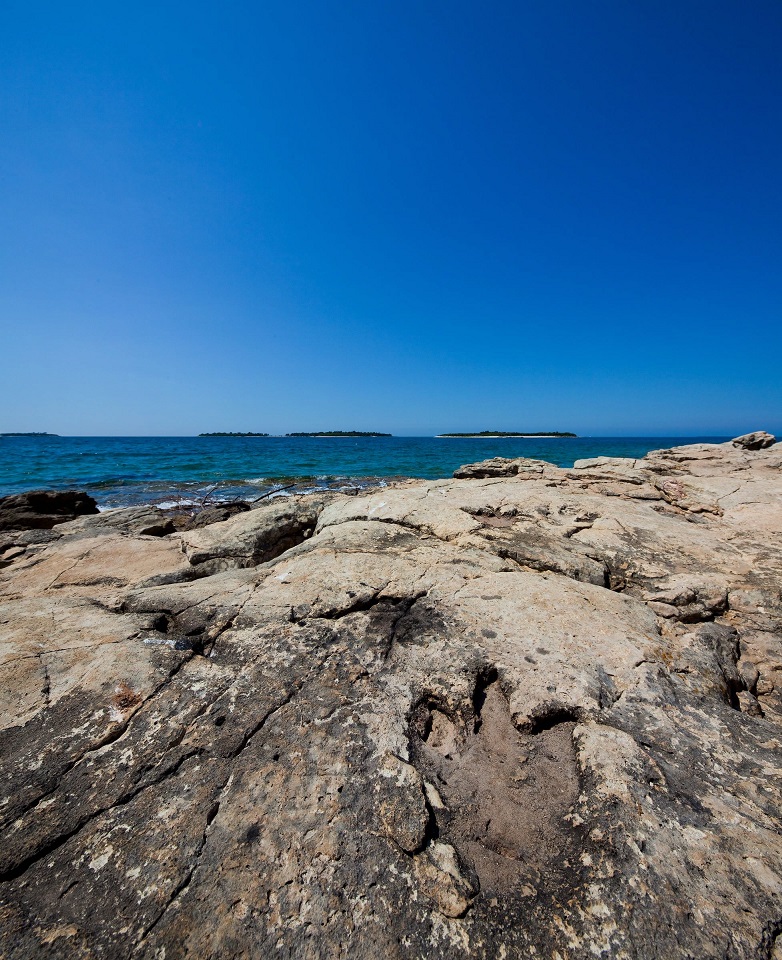
Dinosaur's fossilized feet on Brijuni, Istria / Copyright Romulić and Stojčić
Herbivores and carnivores
Paleontologists have registered more than 10,000 dinosaur remains worldwide: bones, skulls, teeth, coprolite (fossil feces), and fossilized feet. True, not a single coprolite was found in Istria, but according to the Istrian flora in Cretaceous, it is quite clear that herbivores have fed well with rich plants of that time: tall and lush ferns, flowering plants, coniferous and deciduous treetops.
Carnivores have fed on everything that moved. And altogether, they richly fertilized the soil of their habitat so that it would respond with an even richer "table".
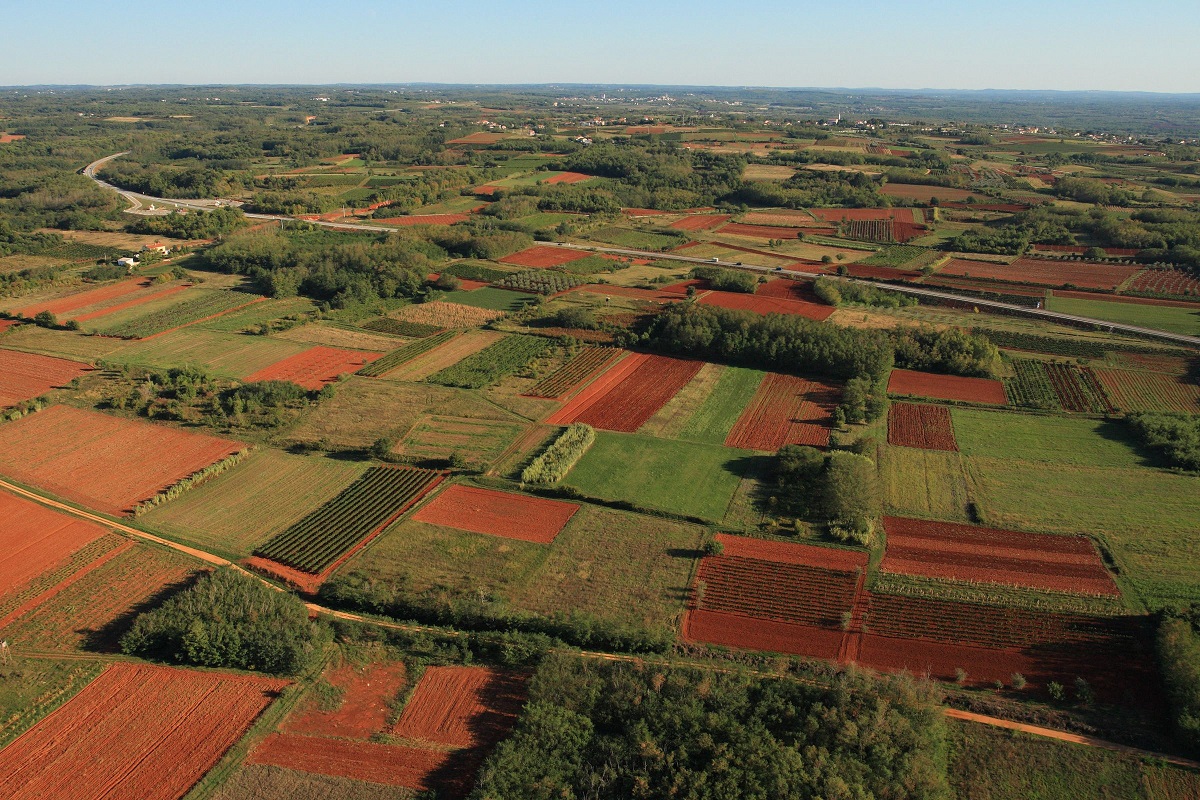
Istria / Copyright Romulić and Stojčić
Among Istrian dinosaurs, scientists mention herbivorous sauropods and carnivorous theropods. The herbivore brachiosaurus is especially impressive. It is 27 meters long and 12 meters high, and weighing about 70 tons.
Certainly, numerous dinosaurs with their huge bodies, appetite, and rich remains have ennobled this Istrian land over millions of years, be it red, black, gray, or white. Hardworking Istrians grow olives, vines, vegetables, fruits here today. They extract the best olive oil, the finest Malvasia, Merlot, Teran, Cabernet Sauvignon from the fruits of the earth.
The autochthonous Istrian Boškarin has been grazing here for two and a half thousand years, together with cows, sheep, and goats. Thousands of guests of this beautiful region enjoy it all today. But it must not be forgotten – in the beginning, there were dinosaurs here.
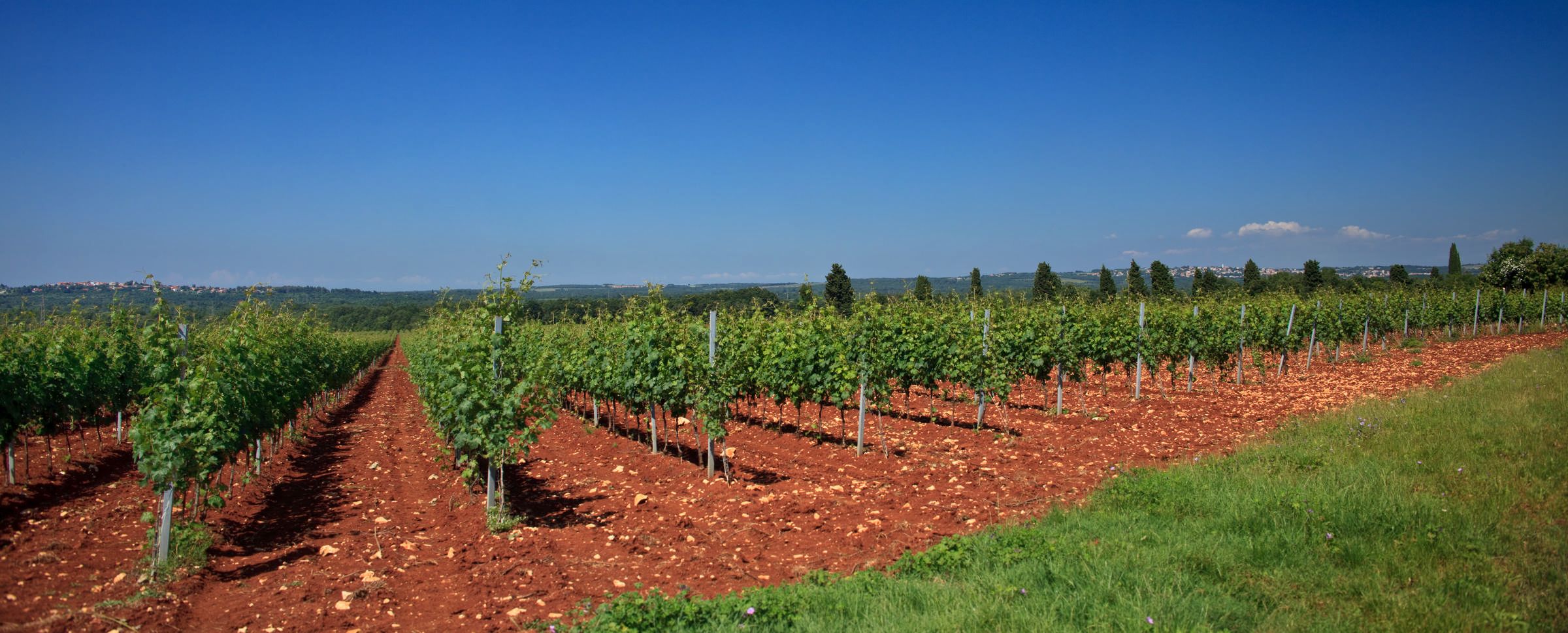
Vineyard in Istria / Copyright Romulić and Stojčić
So, let’s leave room for some unscientific, but simple conclusions. Can so much biomass go unnoticed? Aren't dinosaurs responsible for the exceptional Istrian wine terroir? For the top quality local olive oil?
Dinosaurs may have disappeared 65 million years ago, but before that, they lived, multiplied, and died here in Istria for a full 80 million years.
For the latest travel info, bookmark our main travel info article, which is updated daily.
Read the Croatian Travel Update in your language - now available in 24 languages
Croatian Wine Regions: Istria & Kvarner
January 3, 2019 — In the first article of the Croatian Wine Regions series, TCN unveils Istria and Kvarner, Croatia's westernmost region.
Istria is one of the oldest winegrowing regions in Europe, as the first vines were introduced to the region by the Greeks as early as the 6th century BCE. Today, with just a little over 6,000 hectares under vineyards, Istria carries the moniker "Croatian Tuscany" and is home to a diverse range of high-quality wines.
Wine production in Istria took a full turn in the early 1990s when new generations of winemakers started reinvigorating their family vineyards. Liberated from the socialist-era command economy in which winegrowers were basically coerced to sell their grapes to the state-controlled cooperatives, these new generations of independent winemakers could now focus on quality rather than quantity.
Blessed with the region's exceptional terroir, Istrian producers are nowadays equally championing indigenous as well as international varieties.
In terms of climate, Istria gets the best of both the Mediterranean and mild continental climate. Think palm trees covered in snow — that's Istrian peninsula in a nutshell. While summer heat is tempered by sea breezes from the Adriatic, another key factor is the closeness of the Dinaric Alps, and let's not forget to mention the heterogeneity of Istrian soil.
The terracotta-colored crljenica (red clay soil) is found in coastal areas; it is rich in iron and mainly reserved for growing red varieties, though it can also produce full-bodied and well-structured whites. The central part of the peninsula is known as the "grey Istria" because of its flysch soil (sedimentary rock with grey clay rich in limestone) which is most suitable for white varieties. And last but not least, the rolling hills of inland Istria are characterized by even more limestone, and vineyards in these areas produce aromatic, elegant wines with higher levels of acidity.
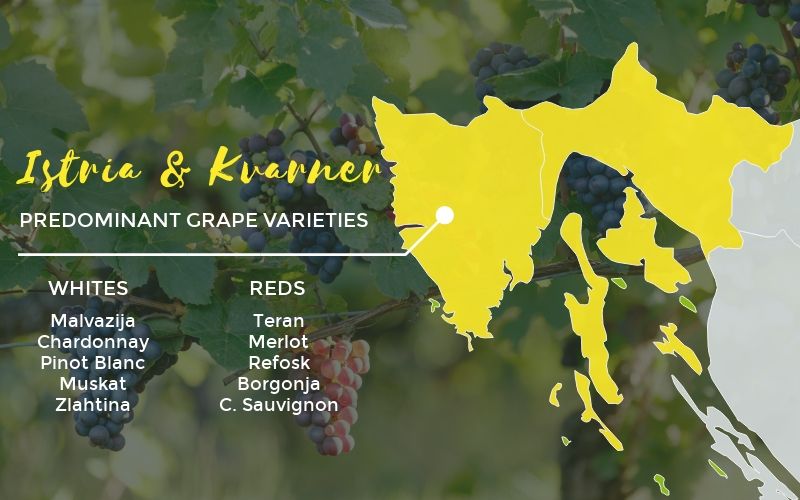
Malvazija Istarska represents 70% of the entire production; it is the most widespread white grape variety in the region, followed by Chardonnay. Other whites include Muškat, Pinot Blanc, Pinot Grigio, and Sauvignon Blanc. As for the reds, if Malvazija is the queen of whites, then Teran is the absolute king of Istrian red wines, although Merlot is actually the most widespread variety. Some critics have even said that Istria could quite possibly be the world's second-best Merlot terroir after Bordeaux, its homeland. Other notable mentions include Refošk, Borgonja and Cabernet Sauvignon, but also Cabernet Franc, Hrvatica, Barbera, and Pinot Noir.
The neighboring Kvarner region, and in particular the island of Krk, are most notable for being home to Vrbnička Žlahtina. The name of this popular white grape variety comes from the fertile plains northwest from the town of Vrbnik, and the old Slavic word zlahten, which means "noble." Žlahtina is indigenous to Krk, and it is by far the island's most planted variety that produces light, fruity wines which are best consumed young.
Stay tuned for more on Croatian wine regions by following TCN's dedicated gourmet page.


